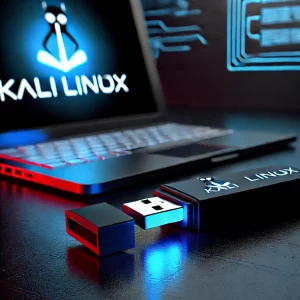Install a Kali Linux into a USB thumbdrive
Estimated Reading Time: 3 min read
Author: Mr.Elliot
Date: November 5, 2024

Sometimes we just want to have or bring along a Kali Linux in our pocket. It is possible using a USB thumbrive or pendrive. Follow these steps and you will have your Kali Linux in a pocket.Here’s a step-by-step guide on installing Kali Linux onto a USB drive to create a portable, bootable version of Kali:
Requirements
- Kali Linux ISO – Download the latest version from the official Kali Linux website.
- USB Drive – At least 8GB (16GB or more is recommended).
- Rufus (for Windows) – A free tool to create bootable USB drives.
- Etcher (for Mac and Linux users) – Another tool for creating bootable drives.
Steps for Windows
- Download and Open Rufus:
- Connect your USB drive.
- Open Rufus and ensure it detects your USB drive.
- Select the Kali ISO:
- Under Boot selection, click Select and navigate to the Kali Linux ISO you downloaded.
- Configure the Drive Settings:
- Partition Scheme: Choose MBR (for BIOS/UEFI compatibility).
- File System: Select FAT32.
- Leave other settings at their default.
- Create the Bootable Drive:
- Click Start.
- Rufus will prompt to write the ISO in ISO or DD mode. Choose ISO.
- Click OK on the warning that all data on the USB will be erased.
- Wait for Rufus to Finish:
- The process will take a few minutes. When it’s done, your USB drive will contain a bootable Kali Linux installation.
Steps for Mac/Linux
- Open Etcher:
- Connect your USB drive.
- Open Etcher.
- Select the Kali ISO:
- Click Flash from file and select your Kali Linux ISO.
- Choose the Target:
- Select your USB drive as the target.
- Flash:
- Click Flash! and Etcher will write the ISO to the USB drive.
- When it’s complete, you’ll have a bootable Kali Linux USB.
Boot from USB
- Restart Your Computer:
- Enter the boot menu (usually by pressing Esc, F2, F10, or F12 during startup).
- Select the USB Drive:
- Choose your USB drive from the boot options.
- Boot into Kali Linux:
- You’ll see the Kali Linux boot menu with options to start the live version, persistent live, or install.
Optional: Set Up Persistence (for Saving Data)
To create persistence (so you can save data across sessions):
- Partition the USB:
- Boot into Kali live.
- Use a tool like GParted to resize the main partition on your USB and create a new ext4 partition labeled
persistence.
- Configure Persistence:
- Mount the new partition and create a configuration file:
- Boot into Persistent Mode:
- Reboot, and select the Live USB Persistence option to start Kali Linux with persistence.
You now have a portable, bootable Kali Linux USB drive with optional persistence.
No comments